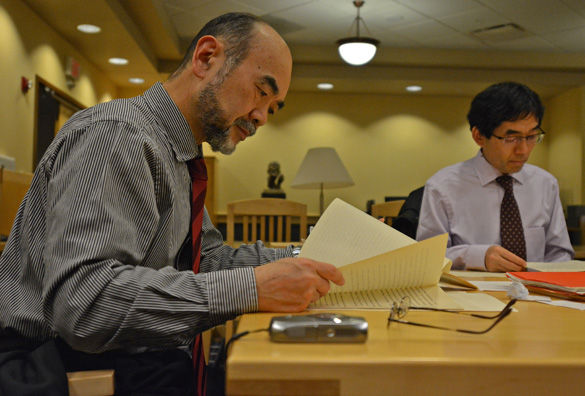University hosts professors from across the Pacific

December 3, 2013
SIU played host to visitors from across the Pacific Ocean this week in conjunction with a Japanese university.
The university welcomed four professors and one graduate student from the John Dewey Society of Japan at Nagoya University in Nagoya, Japan from Sunday until Wednesday morning. Professors Misao Hayakawa, Haruhiko Matsushita, Tomoka Toraiwa, Hiromi Ito and graduate student Shunji Ukai made the long trip to Carbondale to visit the Dewey Center, tour the campus and look at some of Dewey’s original manuscripts in Morris Library.
Located in the fourth largest city in Japan, Nagoya University is one of the Former Imperial Universities, schools formed prior to World War II. Alan H. Kim, an associate professor in Japanese and linguistics, said it is considered one of the most prestigious universities in Japan and has produced four Nobel Prize winners.
Advertisement
Kim said the trip was made possible by the sister-exchange program SIU currently has with Nagoya.
He said he was at the original meeting in Washington 12 years ago between Nagoya and several other universities.
“It used to be that prestigious Japanese universities were lukewarm to accept foreign students from the United States,” Kim said. “A higher education federation contacted universities in Japan and said, ‘Hey you guys are too exclusive. Why don’t you open up?’ They contacted about 10 leading universities and tried to match up with American universities. SIU was included in that list.”
Since then, SIU and Nagoya have exchanged students who wish to study abroad.
Hayakawa said while the main reason for the trip was to visit the Dewey Center and Morris Library, there was another reason as well.
“We get a lot of students from southeast Asia, but not so many from the United States and Europe,” he said. “So we are really happy to have our exchange program with American universities. We are trying to create English education programs to attract students from the United States and European countries. That’s a really key issue for us now over the next five or ten years.”
He said the Japanese government said it is going to select 10 or more universities to be considered global-class universities presentable to the world. Nagoya is attempting to be one of those universities by expanding its studies to the English-speaking world.
Advertisement*
“We have almost 780 private and national universities and maybe 10 of those will be specially selected,” Hayakawa said.
But the trip was not all business. While here, Hayakawa, Matsushita, Ito, Toraiwa and Ukai each said they noticed some stark differences between Nagoya and SIU.
“This is a small college town and it’s really cozy and nice,” Hayakawa said. “People are really nice and kind and have ‘southern hospitality.’ And also this university has a beautiful campus. The size of the university is similar to Nagoya, but the buildings are beautiful and the campus is huge.”
Matsushita said he was expecting to come to a smaller environment, and was surprised when he arrived.
“I thought this would be a very small, countryside college,” he said. “My expectations were very wrong. The equipment is nice and it is a comfortable place. I underestimated the university when I was in Japan. I am very impressed to see the campus. And also, this university has a history much older than mine. It was founded in the 19th Century. That was amazing to me.”
Toraiwa said while the campus is large, the size of Carbondale itself makes Japanese students comfortable.
“Carbondale is kind of a tiny city. People come across one another and that’s why Japanese students have a good experience. You have to depend on people here.”
Yukai originally studied in the United States at Grinnell College in Iowa and said he wants to return to school here after his graduate degree.
“Academia in the U.S. is (sharper) than in Japan,” he said. “Those who want to become a competent scholar should consider coming to the U.S. to see how the education is different from how it is in Japan.”
However Yukai said what some consider an even bigger Carbondale staple was his favorite part of the trip.
The first thing I saw was the street of hippies in Makanda. That was very exciting,” he said. “We don’t see a lot of that. I bought a peace sign because it was so cool.”
Advertisement







